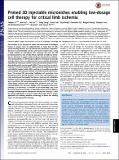Primed 3D injectable microniches enabling low-dosage cell therapy for critical limb ischemia
Author(s)
Li, Yaqian; Liu, Wei; Liu, Fei; Zeng, Yang; Zuo, Simin; Feng, Siyu; Qi, Chunxiao; Wang, Bingjie; Yan, Xiaojun; Khademhosseini, Ali; Bai, Jing; Du, Yanan; ... Show more Show less
DownloadLi-2014-Primed 3D injectable.pdf (1.572Mb)
PUBLISHER_POLICY
Publisher Policy
Article is made available in accordance with the publisher's policy and may be subject to US copyright law. Please refer to the publisher's site for terms of use.
Terms of use
Metadata
Show full item recordAbstract
The promise of cell therapy for repair and restoration of damaged tissues or organs relies on administration of large dose of cells whose healing benefits are still limited and sometimes irreproducible due to uncontrollable cell loss and death at lesion sites. Using a large amount of therapeutic cells increases the costs for cell processing and the risks of side effects. Optimal cell delivery strategies are therefore in urgent need to enhance the specificity, efficacy, and reproducibility of cell therapy leading to minimized cell dosage and side effects. Here, we addressed this unmet need by developing injectable 3D microscale cellular niches (microniches) based on biodegradable gelatin microcryogels (GMs). The microniches are constituted by in vitro priming human adipose-derived mesenchymal stem cells (hMSCs) seeded within GMs resulting in tissue-like ensembles with enriched extracellular matrices and enhanced cell–cell interactions. The primed 3D microniches facilitated cell protection from mechanical insults during injection and in vivo cell retention, survival, and ultimate therapeutic functions in treatment of critical limb ischemia (CLI) in mouse models compared with free cell-based therapy. In particular, 3D microniche-based therapy with 10[superscript 5] hMSCs realized better ischemic limb salvage than treatment with 10[superscript 6] free-injected hMSCs, the minimum dosage with therapeutic effects for treating CLI in literature. To the best of our knowledge, this is the first convincing demonstration of injectable and primed cell delivery strategy realizing superior therapeutic efficacy for treating CLI with the lowest cell dosage in mouse models. This study offers a widely applicable cell delivery platform technology to boost the healing power of cell regenerative therapy.
Date issued
2014-09Department
Harvard University--MIT Division of Health Sciences and TechnologyJournal
Proceedings of the National Academy of Sciences of the United States of America
Publisher
National Academy of Sciences (U.S.)
Citation
Li, Yaqian, Wei Liu, Fei Liu, Yang Zeng, Simin Zuo, Siyu Feng, Chunxiao Qi, et al. “Primed 3D Injectable Microniches Enabling Low-Dosage Cell Therapy for Critical Limb Ischemia.” Proceedings of the National Academy of Sciences 111, no. 37 (September 2, 2014): 13511–13516.
Version: Final published version
ISSN
0027-8424
1091-6490